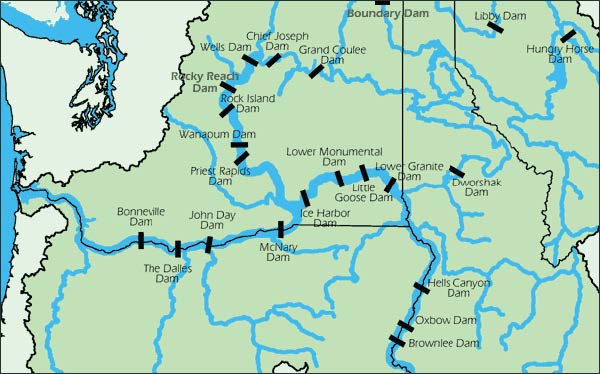forum
library
tutorial
contact

New Approach in Idaho Underway to Better
Direct Salmon Habitat Restoration, Measure Results
by Staff
Columbia Basin Bulletin, December 1, 2017
|
the film forum library tutorial contact |

|
New Approach in Idaho Underway to Better
by Staff
|
 A group of Idaho fisheries conservation leaders has developed a new approach toward evaluating and prescribing effective habitat restoration measures for salmon and steelhead in the upper Salmon River Basin, with potential for the approach to be applied elsewhere.
A group of Idaho fisheries conservation leaders has developed a new approach toward evaluating and prescribing effective habitat restoration measures for salmon and steelhead in the upper Salmon River Basin, with potential for the approach to be applied elsewhere.
The group made a presentation to the Northwest Power and Conservation Council at its November meeting in Coeur d' Alene, Idaho, explaining the Upper Salmon Integrated Rehabilitation Assessment process.
Salmon recovery throughout the Columbia Basin has often been framed in the classic "Four-H" context -- hatcheries, harvest, hydro system and habitat -- with success being measured by a Smolt-to-Adult Return rate (SAR).
But the presenters say only improved tributary habitat sustainability increases the number of juveniles entering the hydro system in a manner that can provide long-term advances toward regional salmon recovery goals.
In the Upper Salmon River and its tributaries, for instance, there is evidence of adequate egg and fry production, and the existing habitat is passable for adult fish returning to their spawning waters. But there is a life-cycle bottleneck in the habitat's ability to support young fish as they develop into smolts.
"Unfortunately, there are few examples of freshwater habitat improvements that are accompanied by quantitative evidence that allow their value to be placed in the context of the SAR equation," states materials provided by the group.
"The reality is availability of funding in the Columbia Basin is changing. We've been informed by Bonneville that there's a lot of pressure from the revenue standpoint," said Mike Edmondson, program manager for the Governor's Office of Species Conservation. "We have to be efficient. We have to be effective, and if we can't prove that the actions that we are proposing will be efficient and effective then it will be even more difficult (to get funding)."
The Upper Salmon IRA uses a new metric, measuring habitat "capacity," or its ability to support the conversion of spring and summer chinook smolts entering the hydro system.
"The IRA differs because we let the biology determine what kind of habitat actions to take through several life stages to ultimately get the number of healthy fish emigrating in the spring," explained Edmondson.
The approach has been applied using regional goals for salmon recovery, providing targets for freshwater capacity requirements that will provide meaningful results. Past habitat assessments, including CHaMP, have provided valuable, near-encyclopedic data on physical conditions of rivers and streams, but the IRA approach is more targeted and should provide measurable results when implemented at the project level, the group said.
"It integrates biology with geomorphology where it is most practical," Edmondson told the council. "We wanted a process where the biology drove the bus."
The IRA process attempts to address questions such as what types of rehabilitation work are needed, where is it needed, and just how much work is necessary to produce results.
As examples, the IRA approach has identified stream stretches in the Upper Salmon Basin that are much wider and shallower than they used to be, with adverse effects on rearing habitat, and it has revealed that improving rearing habitat near spawning beds called redds would be far more effective than pursuing rearing habitat far downstream. Or, it was noted, there may not be a need to invest in measures to improve redd capacity that is already adequate.
"Historically, reproduction was occurring farther up in the basin," Edmondson said. "They had more rearing capacity."
Since life cycles also have seasonal dimensions, it may be that improvements to streams as they are in the winter may also be highly effective in improving smolt development and survival, Edmondson said, noting that a thorough look at winter habitat capacity is the next stage of developing the Upper Salmon IRA, as recommended by an Independent Scientific Review Panel in 2013.
As habitats are strategically implemented, or "stacked," throughout a drainage the results are expected to provide measurable advances toward recovery goals, Edmondson explained.
"We could get to at least recovery levels, and probably beyond recovery levels," Edmondson said.
Jude Trapani, a representative of the Bureau of Reclamation involved with developing the process, told the council that "We can do this with just about any drainage in the Columbia River system. The confidence levels are very similar."
Mark Davidson, a representative of the Nature Conservancy, pointed out that the IRA process should yield project proposals that have more specificity than broader, shot gun approaches to habitat restoration. That can be very valuable in approaching landowners whose cooperation is needed for many projects to proceed, he said.
learn more on topics covered in the film
see the video
read the script
learn the songs
discussion forum
